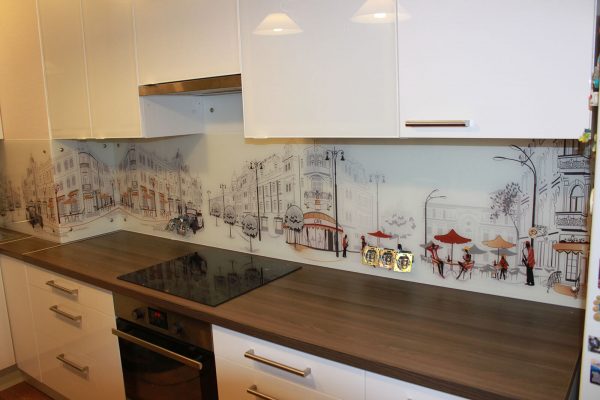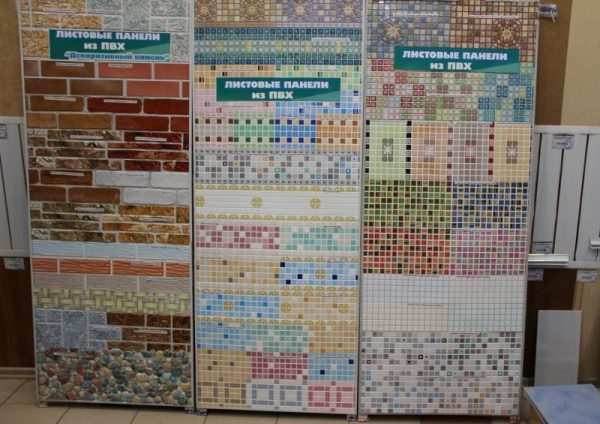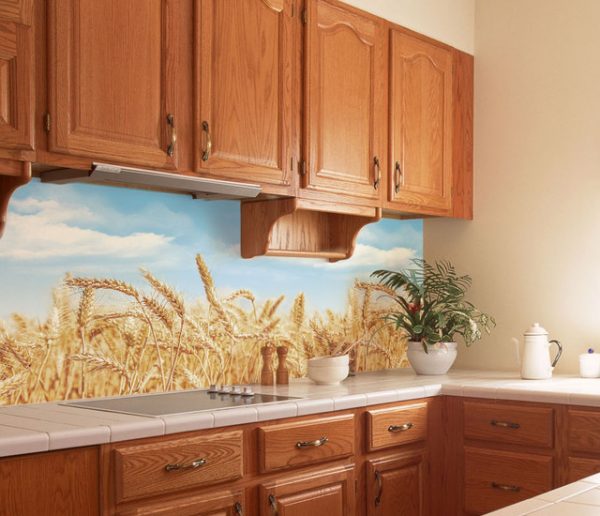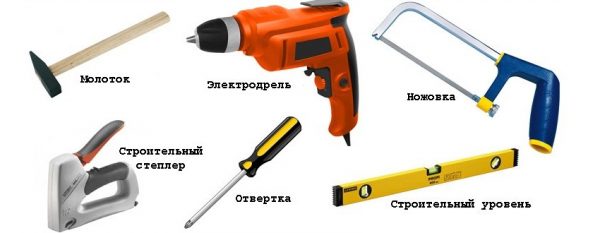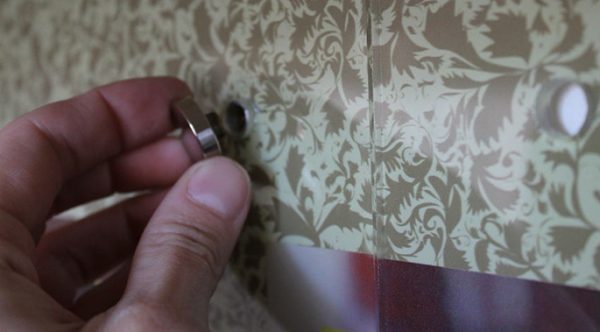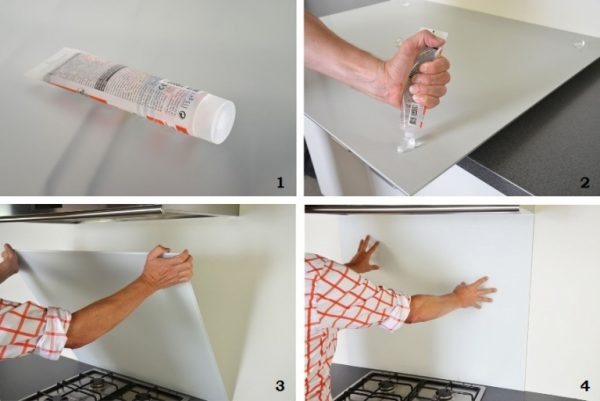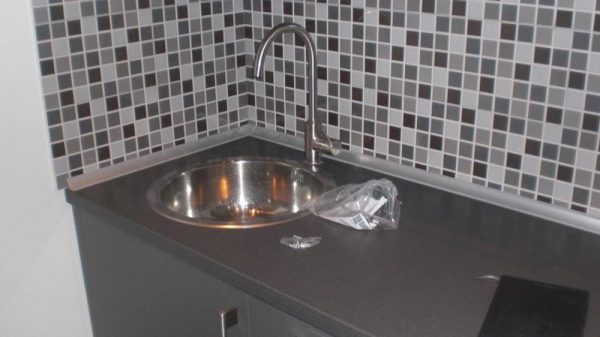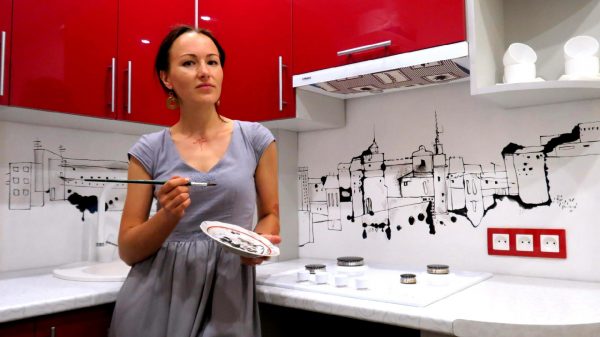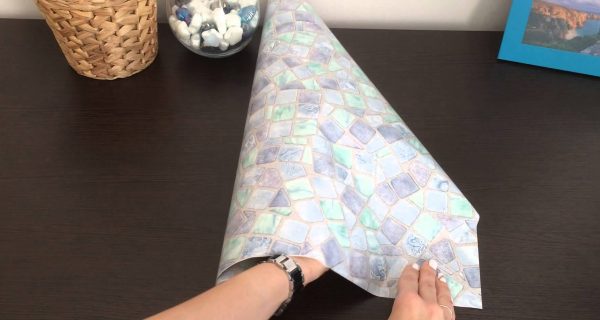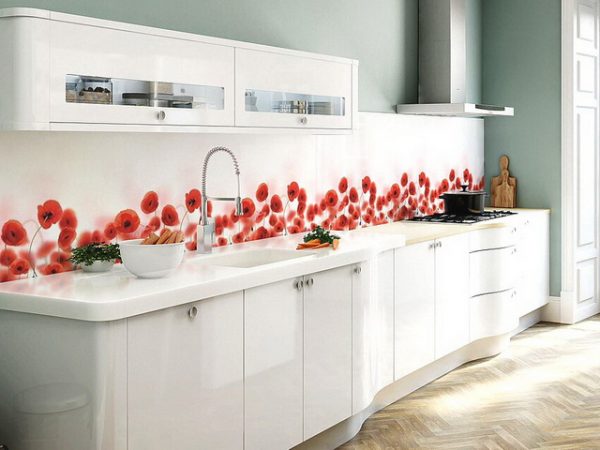Kitchen cutting table, sink, stove are usually located along one wall. When cooking, splashes fly from them, fat streaks form on the walls. That is why the wall adjacent to the headset must be reliably protected so that it does not lose its beautiful appearance. Wanting to inexpensively, effectively finish the wall, you need to pay attention to the plastic apron. There are a number of ways how to glue an apron in the kitchen from plastic, it will be an excellent alternative to tiles, ceramic tiles.
- Varieties of Kitchen Aprons
- Pvc panels
- ABS
- Polycarbonate
- Advantages and disadvantages of plastic panels
- Installation rules for PVC apron
- Materials, tools
- Mounting Methods
- On guides - special profiles
- Screws
- To the crate
- On glue
- Preparation of panels - layout, cutting
- Final finish
- Apron decoration
- Decorative painting
- Photowall-paper
- Film
- Apron Care
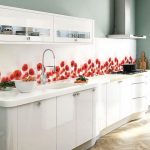
Varieties of Kitchen Aprons
Under the kitchen apron understand the distance between the surface of the table and the bottom edge of the wall cabinets. The beautiful design of the apron gives the finished look to the whole kitchen. This coating has two functions:
- protective - protects the wall from negative effects, easy to clean, resistant to household chemicals, high temperatures, humidity;
- aesthetic - decorates the kitchen, serves as an original accent in the interior, “collects” the style together.
The material for the manufacture of the apron can be different - polycarbonate, ABS, PVC panels. Plastic lining is almost never used now, it has become obsolete, and chipboard, MDF are not suitable for this purpose.
The design and appearance of the material is also diverse. Some prefer monophonic panels, others prefer an apron with imitation mosaics. Unusually look aprons with drawings, photos, artistic texture, wood or natural stone. There is material of the original color, under painted glass, stained glass, even brick. As for models with drawings, they are applied to the plastic itself by embossing or printed on the film covering the panels on top.
to contents ↑Pvc panels
Most often on sale you can find just such a coating. The length of the panels is 2.6-2.7 meters, there are products 3 meters long. The thickness is 0.5-1 cm. PVC is the most inexpensive material for an apron, but it has a lot more minuses.
It's important to know! Plastic based on polyvinyl chloride very quickly begins to fade, scratch, so it will not look beautiful on the wall for long.
It is easy to wash the material only if there are fresh spots. It will be problematic to remove stubborn fat, because even ordinary soda will leave unsightly streaks and defects on it. It is forbidden to use aggressive chemistry on PVC for the same reason. Installation of PVC is simple, but leaving seams with gaps will lead to the multiplication of fungus and bacteria. Other problems that may arise when buying panels:
- difficult dismantling (PVC has to be glued to liquid nails, epoxy-based adhesives, and it is difficult to tear them off);
- poor reaction to high temperatures - a PVC plate can melt;
- low environmental friendliness - when heated, this type of plastic emits harmful substances, especially with low quality.
ABS
This plastic is better suited for an apron, although it costs almost like a mosaic, tiled coating.ABS is shockproof, it is made on the basis of acrylonitrile, styrene. It is resistant to cleaning with abrasives, chemicals, lightweight. In fact, it is impossible to clean the material with solvents and acetone, other products are allowed for use.
ABS plastic is harmless to humans, diverse in patterns, textures. Minus - burnout in the light, yellowing with time or an initially yellowish tone.
to contents ↑Polycarbonate
Of all types of plastic aprons, the most durable and reliable is polycarbonate. The material from carbonate glass is transparent, it is almost impossible to break, pits, scratches from moderate exposure are not formed. The apron will not fade, turn yellow, it is fireproof. The disadvantages include the higher cost of the product.
Advantages and disadvantages of plastic panels
Compared with tiles and other materials, plastic (except PVC) has a number of advantages. Here are the main ones:
- reasonable price;
- moisture resistance;
- the ability to withstand elevated temperatures, the negative impact of household chemicals, food acids, fats;
- resistance to mold reproduction (if installation was carried out correctly);
- light weight of material;
- tight fit to the wall;
- the ability to do it yourself;
- the ability to adjust the height, length.
Due to the low price and cost of work compared to tiles, which should only be fixed with experience, a plastic apron can be changed more often - this will not cause a “hole” in the budget. When replacing the apron, you do not even need to move the furniture.
Cons of the material is also present. Do not glue it next to a gas stove - any type of plastic will deform over time, even the most fire-resistant, because the effects of heat will be frequent and long. Plastic should not be rubbed with hard brushes.
Polycarbonate will not withstand intensive processing - small scratches will still appear. Only some types of drawing will alleviate this drawback: if the surface is decorated with relief images, made under aged stone or brick, small blemishes will be invisible.
to contents ↑Installation rules for PVC apron
You can install a plastic apron in various ways - stick it on the wall, fix it with screws, screw it onto the crate. Thin sheets are most often attached to glue. You can even make a frame, and the finished apron will be removable. Before starting work, it is necessary to prepare the surface - to level, primer. If necessary, under the panels, you can skip cables by making a recess in the wall, after plastering.
to contents ↑When sticking thick plastic, you don’t even have to remove the old coating, it is allowed to immediately paste new material on it. If the repair in the kitchen is already completely finished, it is better to screw the plastic with screws - damage to the walls will be minimal.
Materials, tools
Depending on which option is selected, different accessories for mounting the apron may be required:
- metal profiles;
- wooden bars;
- self-tapping screws;
- screwdriver;
- dowels for lathing;
- building level;
- glue;
- ruler, tape measure;
- pencil;
- hammer.
Mounting Methods
Mounting is carried out depending on the wishes of the user, the degree of evenness of the wall, the presence or absence of the old coating.
On guides - special profiles
It is better to use this method if it is planned to regularly change plastic panels in the future. Material can be removed without damaging the base. It is necessary to direct the position of the plastic with special iron rails, which are fixed in a horizontal position on the wall with screws. Plastic is laid on guides, each pair of which serves as “rails”. Then you can push the old apron, push the new one.
to contents ↑Screws
Fastening with self-tapping screws is an uncomplicated option, which is ideal for finished walls or for installing transparent painted panels. You can also stick them, but the glue is able to shine through, distort the pattern. The work is carried out according to this scheme:
- Make holes in the wall with a drill, into which then self-tapping screws, roof rails will be inserted.
- Cut the necessary pieces of plastic.
- Arrange the beacons by level, they will serve as a support for the panels.
- Brackets or screws to attach the panel.
- Cover the caps of the screws with special caps, caps.
- If necessary, hide the wiring in the gap between the panels and the wall, because there will remain a fairly large space.
To the crate
A spacious room will not suffer too much if the wall is slightly reduced when using the crate. Typically, this method is used when you need to apply a large apron, and the wall is too uneven. The installation of the crate will fix this drawback.
The lathing is interconnected metal, wooden slats attached to the wall around the perimeter of the apron. Usually, at first, a crate is made strictly according to the size of the apron, then horizontal and vertical strips are fixed inside with screws to strengthen and strengthen the structure. They are placed 50 cm or less apart. Under the crate, you can arrange wiring, controllers, sockets. An apron is attached to the crate with brackets.
to contents ↑On glue
Attaching panels to glue is very simple. After gluing, the plastic will become tougher and will not be subject to deformation.
Note! The wall differences should not exceed 1 cm, otherwise it will not work to glue the apron securely.
The procedure is as follows:
- Make markings on the walls using the level, accurately mark the upper, lower borders of the apron.
- Cut the material according to the marking so that the plastic slightly goes behind the furniture.
- Take dry building glue or liquid nails (preferably white), apply to the material.
- Press the plastic against the wall.
- The edges are glued more securely, but it is better to fix them with small brackets, self-tapping screws.
- Cover the sections with skirting boards, mask with trims, if necessary.
Preparation of panels - layout, cutting
To install the panels correctly, it is important to determine their direction in advance. If the panels are wide, they are placed horizontally so that there are few joints. Narrow sheets are cut and attached with vertical seams. You can cut the material with ordinary scissors, a sharp knife, a hacksaw with small teeth. The thinnest sections are achieved by nichrome thread. They can also be made by professionals practicing laser cutting.
to contents ↑Final finish
The gaps between the apron panels and the countertop must be covered with a curb. It will not allow water to penetrate the gap, protect it from dirt, food debris, fat, hide defects. Also, the border has a decorative function.
You need to choose a plastic product that is optimally suited to the panels, and it is not difficult to mount it. The shape of the border is flat, triangular, curly, rectangular. It is planted on glue, liquid nails.
If there is a bar on the countertop, there is no need for such a border. It is necessary to remember also about angular overlays - they too are selected together with panels of an apron or with a table-top.
to contents ↑Apron decoration
The color of the apron is chosen in accordance with the design, the tone of the furniture in the kitchen. In a small room, do not use dark shades that visually reduce the room even more. It is better to buy an apron of light color. Completely transparent plastic without a pattern can be independently decorated, for which different techniques are used.
Decorative painting
To paint the material is quite possible with paint.For this, acrylic dyes are bought in the needlework store, in construction markets, which are easy to apply and mix well with each other. The picture can be found on the Internet, the main thing is that it fits well with the overall design of the kitchen. It is better not to pick up complex drawings, they will cause a wall “overload”. The picture may be large in the center. The repeating pattern or the decor applied in a mirror image looks great.
to contents ↑Photowall-paper
Wallpapering will be the easiest and most beautiful option for decorating plastic. The material is glued to the panels, completely removing particles of dirt, dust, air bubbles. In order not to spoil the result, you can turn to professionals, although if you observe cleanliness in the room, you can achieve a good effect. A special transparent glue is applied directly to the drawing, then it is pressed against a plastic apron. After drying, you can attach the material to the wall.
to contents ↑Film
Joining a self-adhesive film also serves as a good way to decorate an apron. The variety of colors of the film is huge, there is even the opportunity to order printing on it according to an individual drawing. So in the kitchen you can even get vivid photos and incredible pictures. Next, you need to perfectly smoothly stick the film, for which it is disconnected gradually, without tearing off the substrate immediately completely. Work requires attention and patience. To slow down the speed of setting the material with the apron, the plastic is slightly moistened with water, which will allow you to adjust the position of the film. It is necessary to remove air from under it, otherwise the result will be spoiled.
to contents ↑Apron Care
The apron should be washed periodically with soap and water, using a soft sponge, a cloth. Instead of soap, you can take the liquid for washing dishes, but after it there may remain stains if you do not rinse it out enough. It is better not to use abrasives, and in the presence of frozen fat, try to soak it with soap. During operation, it is necessary to ensure that children do not scratch the material, and also exclude its sharp overheating, although expensive panels are quite resistant to this kind of damage. Saving on the quality of the material is not worth it, because it should serve you for a long time faithfully.

